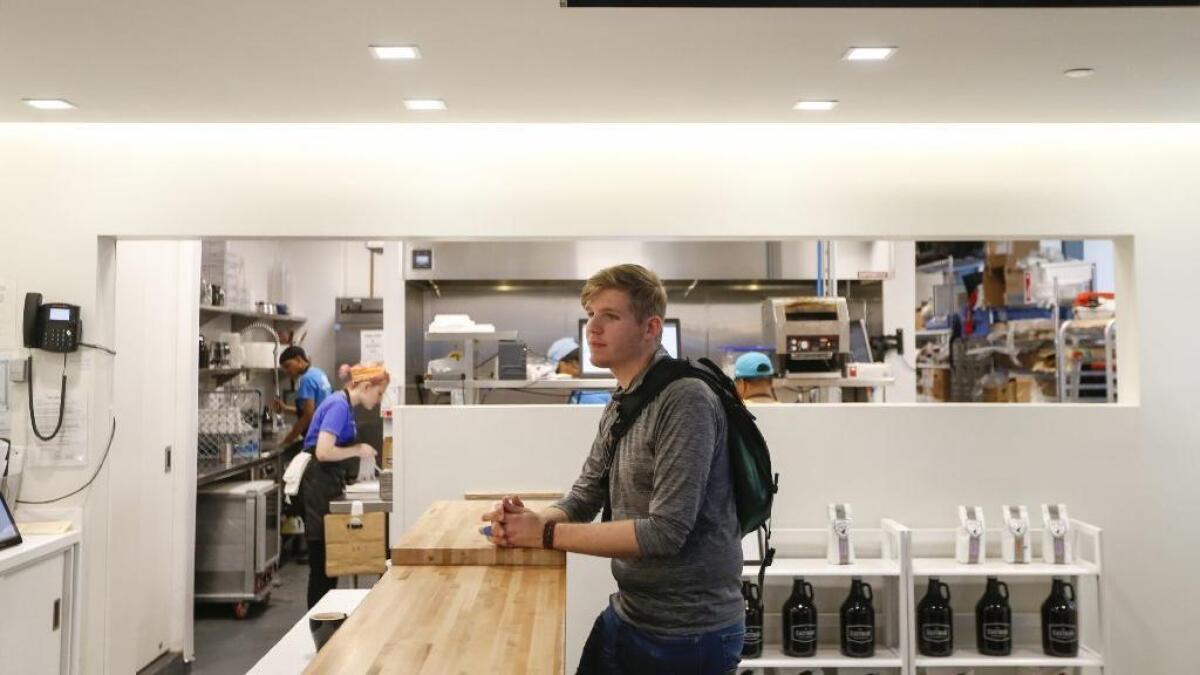Why restaurants want you to order food on your phone

- Share via
Swipe, click, food.
The ability to order food with the tap of a few buttons on a smartphone is becoming widespread — even fast-food companies are getting in on the action. But the technology — which in some cases tracks a customer’s location and times food preparation accordingly — can vary widely. And restaurants admit that some customers are still wary about the freshness of their food when ordering ahead.
“I think some users assume [their food] would be sitting on that counter for them because that’s how most in the industry do it,” said Eastman Egg restaurant founder and CEO Hunter Swartz, who focused on a mobile app as a cornerstone of the Chicago eatery’s development. “As much as we had to educate the public about our food, there’s been just as much education for the app.”
Mobile ordering is becoming a crucial piece of many restaurants’ plans because it can boost sales. Customers spend more and visit more often, on average, when they’re using a phone to order their food.
The first restaurants to make mobile a big part of their business were the ones that rely heavily on delivery: pizza makers. At Domino’s, you can order just by texting an emoji of pizza or opening its app. Pizza Hut and Papa John’s have made big advances, too, and all three credit about half their sales to mobile orders.
Few restaurants are as far along as the delivery operators, but many have advanced their own apps by leaps and bounds to capture more customers on the go.
Starbucks launched mobile pay through its app a year ago, and it now accounts for about 5% of sales, Chief Financial Officer Scott Maw said at a conference last week. That jumps to 20% of transactions at peak times at several hundred of its urban stores. The company expects that number to accelerate quickly in the near future, as customers get more comfortable with the technology. A quarter of Starbucks’ customer payments already are made with its smartphone app.
Maw also said Starbucks’ app eventually will be able to use weather data to market different food and drink items to customers, such as a pumpkin spice latte on a chilly October day.
In June, Dunkin’ Donuts debuted mobile ordering nationwide and Chick-fil-A launched a new app with mobile ordering capabilities. Taco Bell has had mobile ordering capabilities on its app since 2014, but sister company KFC doesn’t offer it. McDonald’s, the world’s largest burger chain, has been testing its own mobile ordering system since the spring and has said digital initiatives are a priority in the near future.
Among fast-food restaurants, the frequency of customer visits rises 6% and average spending per visit jumps about 20% when technology is used to place an order, according to a Deloitte survey released this week. Visits tend to increase because technology makes it easier to repeat an order automatically, and repeat orders of custom or upgraded drinks lead to increased sales.
The data collected from mobile ordering apps also can shine light on the makeup of customers.
Capabilities often differ vastly from app to app.
“You’ve got a tremendous variability in terms of sophistication,” Deloitte restaurant analyst Andrew Feinberg said. “You’ve got Starbucks, Panera, Domino’s that are doing well, while you’ve got others that have been trying for a while and still struggling with it,” he said. “A lot of restaurants have a very long way to go.”
Starbucks’ mobile ordering system stores previous orders but doesn’t let customers designate a favorite store — a potentially frustrating missing link for a commuter who might pass several Starbucks stores on the way to work. Orders also can’t be placed in advance for a specific time. On the other end, Dunkin’ Donuts’ app lets customers order up to a day in advance and select a favorite store.
In Chicago, Eastman Egg’s app uses location technology to track how close customers are to a store in order to know when to start preparing their food. The app sends a signal to the kitchen when the customer is getting close.
“We’re trying to change the way people think about mobile,” Eastman Egg CEO Swartz said. “What I’m trying to build at Eastman is that you order it and it’s available right when you walk in.”
Feinberg said the technology gets exponentially more complex for big chains.
“For a single restaurant, it’s actually pretty easy to figure out,” he said. “It’s very complex when the company has, say 500 stores.”
There’s also a behind-the-scenes flow that has to be figured out before mobile ordering and payments can be implemented. Many restaurants, including Chipotle and Los Angeles-based Sweetgreen, have separate prep lines so mobile and online orders aren’t held up by a line of in-store customers.
For restaurants developing mobile apps, there’s also another issue: customer overload. Dozens of major restaurant brands offer mobile ordering, but customers download an average of only three restaurant apps to their phones, according to Deloitte. That’s increasing the pressure for the restaurants that haven’t implemented mobile ordering to do it quickly.
“There’s kind of a race for shelf space — except it’s a race for a share of customers’ minds and phones,” Feinberg said.
ALSO:
Median incomes are up and poverty rate is down
Can the 2017 Chevy Bolt EV really go 200-plus miles with no recharge? We try it
Wells Fargo is eliminating retail sales goals after settlement over aggressive tactics



